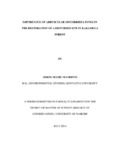| dc.description.abstract | Kakamega forest, a major reservoir of biodiversity in Kenya has experienced
degradation over a long period of time due to human disturbance. This disturbance
has resulted in a heterogeneous mixture of vegetation including disturbed primary
forest, secondary forest, clearings and glades, and timber plantations. Restoration of
the forest ecosystem has included the re-establishment of native tree species in order
to accelerate recovery of the degraded areas and connect formally joined forest
fragments. The degraded habitats, besides losing the above ground vegetation, have
also lost the below-ground biological organisms. Often, restoration efforts have
disregarded these below-ground organisms, some of which are crucial in maintaining
plant community structure. It was hypothesised that the mycorrhizal abundance and
diversity in soils of these degraded areas would affect plant growth and establishment
rate in the restoration efforts. The study developed a vegetation map of a disturbed
site within the Forest and assessed the mycorrhizal abundance and diversity in soils of
the identified vegetation stands. Arbuscular mycorrhiza fungi abundance and diversity
was found to be low at the disturbed site and also varied according to vegetation type
and soil properties. The study also sought to determine the mycorrhizal dependancy of
Erythrina abyssinica, Markhamia lutea, and Senna spectabilis seedlings which were
some of the tree species identified for planting in the restoration efforts. The seedlings
were found to be facultatively mycorrhizal but contamination of the experiment
obscured the clear benefit of arbuscular mycorrhiza fungi colonization on seedling
establishment. | en_US |

